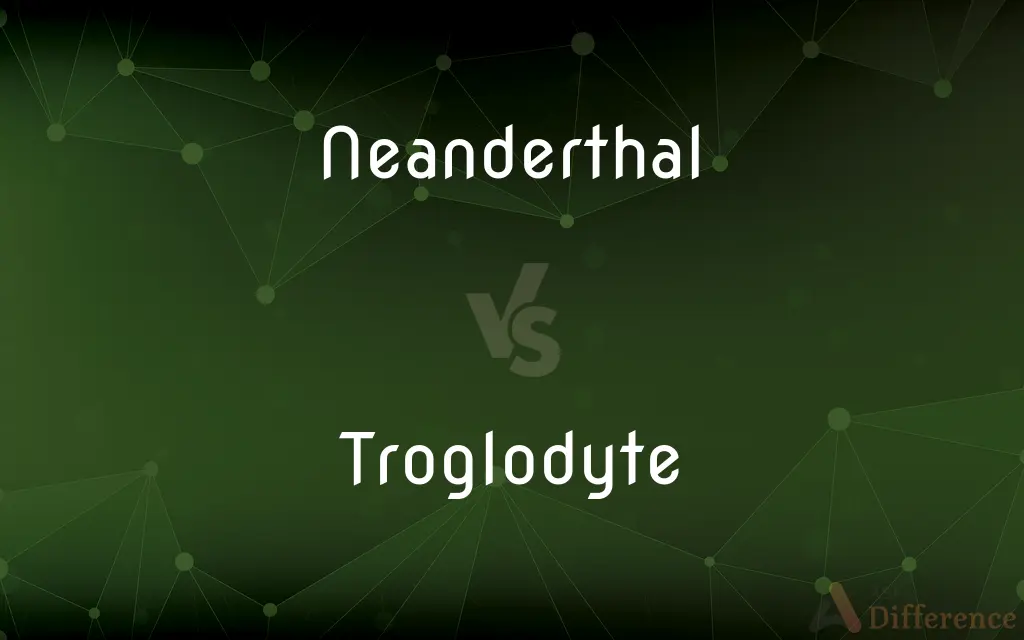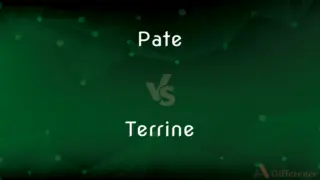Neanderthal vs. Troglodyte — What's the Difference?
Edited by Tayyaba Rehman — By Urooj Arif — Updated on April 9, 2024
Neanderthals were a distinct species of ancient humans who lived alongside early Homo sapiens, while "troglodyte" is a term used historically to describe cave dwellers, not a specific species.

Difference Between Neanderthal and Troglodyte
Table of Contents
ADVERTISEMENT
Key Differences
Neanderthals, scientifically known as Homo neanderthalensis, were a species of archaic humans who inhabited Eurasia from approximately 400,000 to 40,000 years ago. They were closely related to modern humans, with distinctive physical features adapted for survival in cold climates. In contrast, the term "troglodyte" has been used in various contexts, often pejoratively, to refer to any human group living in caves, irrespective of their period or species. This term lacks a precise scientific definition and is not associated with a specific lineage of human evolution.
Neanderthals are known for their role in the human evolutionary timeline, contributing genetically to modern human populations outside of Africa through interbreeding. On the other hand, "troglodyte" does not refer to a specific evolutionary stage but rather to a lifestyle or habit of dwelling in caves, which was common among different human and hominin species, including some Neanderthals.
The study of Neanderthals is grounded in paleoanthropology, focusing on their physical characteristics, culture, and genetic contributions to modern humans. The concept of a troglodyte, however, emerges more from historical and cultural narratives than from scientific study, often used in literature and folklore to depict primitive or reclusive human behaviors.
Archaeological evidence shows Neanderthals made tools, wore clothes, and sometimes buried their dead, indicating complex social behaviors and cultural practices. While some troglodytes, in the broader sense, might have shared similar practices, the term is too broad and non-specific to draw direct cultural or behavioral parallels.
The distinction between Neanderthals and the concept of a troglodyte underscores the difference between a scientifically recognized group of ancient humans with a defined place in human evolution and a general, non-specific term for humans or hominins who lived in caves.
ADVERTISEMENT
Comparison Chart
Definition
A species of archaic humans
A general term for cave dwellers
Scientific Basis
Well-defined in paleoanthropology
Lacks precise scientific definition
Time Period
Approximately 400,000 to 40,000 years ago
Varied, not specific to any time period
Physical Features
Adapted to cold climates, distinct from modern humans
No specific features, varies with usage
Cultural Practices
Tool-making, clothing, burial of the dead
Depends on the group; not specific
Genetic Contribution
Contributed to the gene pool of non-African modern humans
No genetic contribution as it is not a specific lineage
Habitat
Eurasia
Worldwide, wherever caves are found
Compare with Definitions
Neanderthal
An extinct species of archaic humans.
Neanderthals lived in Europe and parts of Asia during the Ice Age.
Troglodyte
Historically refers to cave dwellers.
Ancient troglodytes used natural caves as shelters and homes.
Neanderthal
Known for their robust build and adaptive skills.
Neanderthals crafted sophisticated stone tools for hunting.
Troglodyte
Varied in cultural practices.
Cultural practices of troglodytes depended on their specific time, location, and community.
Neanderthal
Had complex social behaviors.
Evidence of Neanderthal burials suggests they had rituals for the dead.
Troglodyte
Not a specific species but a lifestyle.
The term troglodyte has been applied to various prehistoric and historic peoples.
Neanderthal
Adapted to cold climates.
Neanderthals developed physical traits like a shorter, stockier body to conserve heat.
Troglodyte
Associated with primitive living conditions.
Troglodytes are often depicted as having a rudimentary existence.
Neanderthal
Contributed genetically to modern humans.
DNA analysis shows that Neanderthals interbred with ancestors of modern Europeans and Asians.
Troglodyte
Can refer to modern recluses.
The word troglodyte is sometimes used metaphorically to describe someone who avoids society.
Neanderthal
Neanderthals (, also Neandertals, Homo neanderthalensis or Homo sapiens neanderthalensis) are an extinct species or subspecies of archaic humans who lived in Eurasia until about 40,000 years ago. They most likely went extinct due to assimilation into the modern human genome (bred into extinction), great climatic change, disease, or a combination of these factors.
Troglodyte
Often Troglodyte A member of a fabulous or prehistoric race of people that lived in caves, dens, or holes.
Neanderthal
A species of extinct hominins (Homo neanderthalensis) that lived throughout most of Europe and western and central Asia during the late Pleistocene Epoch until about 30,000 years ago. Members of this species had a large skull and stocky build and are associated with Middle Paleolithic tools.
Troglodyte
A person considered to be reclusive, reactionary, out of date, or brutish.
Neanderthal
An individual belonging to this species.
Troglodyte
A nonhuman ape. Not in scientific use.
Neanderthal
(Slang) A crude, boorish, or slow-witted person.
Troglodyte
An animal that lives underground, as an ant or a worm. Not in scientific use.
Neanderthal
Also Ne·an·der·tal (-tôl′, -täl′) Of, having to do with, or resembling Neanderthals.
Troglodyte
A member of a supposed prehistoric race that lived in caves or holes, a caveman.
Neanderthal
(Slang) Crude, boorish, or slow-witted.
Troglodyte
(by extension) Anything that lives underground.
The cave was populated by albino scorpions, blind salamanders, and other troglodytes.
Neanderthal
Alternative case form of Neanderthal
Troglodyte
A reclusive, reactionary or out-of-date person, especially if brutish.
Neanderthal
Alternative case form of Neanderthal
Troglodyte
The Eurasian wren, Troglodytes troglodytes.
Neanderthal
Uncouth in manners or appearance.
Troglodyte
(computing) A person who chooses not to keep up-to-date with the latest software and hardware.
Neanderthal
Of, pertaining to, or named from, the Neanderthal, a valley in the Rhine Province, in which were found parts of a skeleton of an early type of man. The skull is characterized by extreme dolichocephaly, flat, retreating forehead, with closed frontal sutures, and enormous superciliary ridges. The cranial capacity is estimated at about 1,220 cubic centimeters, being about midway between that of the Pithecanthropus and modern man.
Troglodyte
One of any savage race that dwells in caves, instead of constructing dwellings; a cave dweller, or cave man. Most of the primitive races of man were troglodytes.
In the troglodytes' country there is a lake, for the hurtful water it beareth called the "mad lake."
Neanderthal
Similar to or reminiscent of a neanderthal human; troglodytic; primitive and uncultured.
Troglodyte
An anthropoid ape, as the chimpanzee.
Neanderthal
A neanderthal human being; a member of the race Homo sapiens neanderthalensis; as, neanderthals were shorter than modern humans.
Troglodyte
The wren.
Neanderthal
One resembling a neanderthal human; a troglodyte; a cave man.
Troglodyte
One who lives in solitude
Neanderthal
A person of primitive, unenlightened or uneducated opinions or attitudes; one with a regressive social or political outlook; - used disparagingly.
Troglodyte
Someone who dwells in a cave
Neanderthal
Extinct robust human of Middle Paleolithic in Europe and western Asia
Neanderthal
Ill-mannered and coarse and contemptible in behavior or appearance;
Was boorish and insensitive
The loutish manners of a bully
Her stupid oafish husband
Aristocratic contempt for the swinish multitude
Neanderthal
Relating to or belonging to or resembling Neanderthal man;
Neanderthal skull
Common Curiosities
Who were the Neanderthals?
Neanderthals were an extinct species of archaic humans who lived in Eurasia up to about 40,000 years ago.
Did Neanderthals and troglodytes coexist?
Neanderthals may be considered troglodytes in the sense that they sometimes lived in caves, but the term "troglodyte" can refer to any cave dwellers.
Can modern humans have Neanderthal DNA?
Yes, most people outside of Africa have a small percentage of Neanderthal DNA, indicating past interbreeding between Neanderthals and early modern humans.
What distinguishes Neanderthals from the concept of troglodytes?
Neanderthals are a specific, scientifically recognized species of ancient humans, whereas "troglodyte" is a broad term for any humans living in caves.
How did Neanderthals adapt to their environment?
Neanderthals adapted through physical traits suited for cold climates and developed tools and cultural practices for survival.
What does troglodyte mean?
"Troglodyte" is a term used to describe individuals or groups that lived in caves, without referring to a specific species or time period.
How are troglodytes depicted in culture and literature?
Troglodytes are often portrayed as primitive or reclusive, living in a state removed from modern society or in literal caves in historical contexts.
Were all cave dwellers considered troglodytes?
Historically, the term could be applied to any individuals living in caves, regardless of their cultural or technological advancements.
Did Neanderthals have complex societies?
Evidence suggests Neanderthals had complex social structures, evidenced by their tools, art, and burial practices.
Is "troglodyte" a scientific term?
No, "troglodyte" is not used scientifically to classify any specific group of humans or hominins; it's more of a cultural or historical term.
Share Your Discovery

Previous Comparison
Gastropod vs. Mollusk
Next Comparison
Pate vs. TerrineAuthor Spotlight
Written by
Urooj ArifUrooj is a skilled content writer at Ask Difference, known for her exceptional ability to simplify complex topics into engaging and informative content. With a passion for research and a flair for clear, concise writing, she consistently delivers articles that resonate with our diverse audience.
Edited by
Tayyaba RehmanTayyaba Rehman is a distinguished writer, currently serving as a primary contributor to askdifference.com. As a researcher in semantics and etymology, Tayyaba's passion for the complexity of languages and their distinctions has found a perfect home on the platform. Tayyaba delves into the intricacies of language, distinguishing between commonly confused words and phrases, thereby providing clarity for readers worldwide.
















































